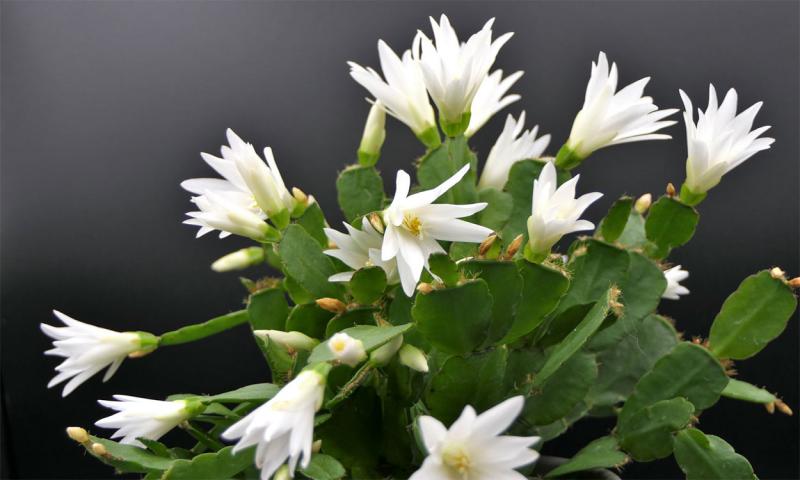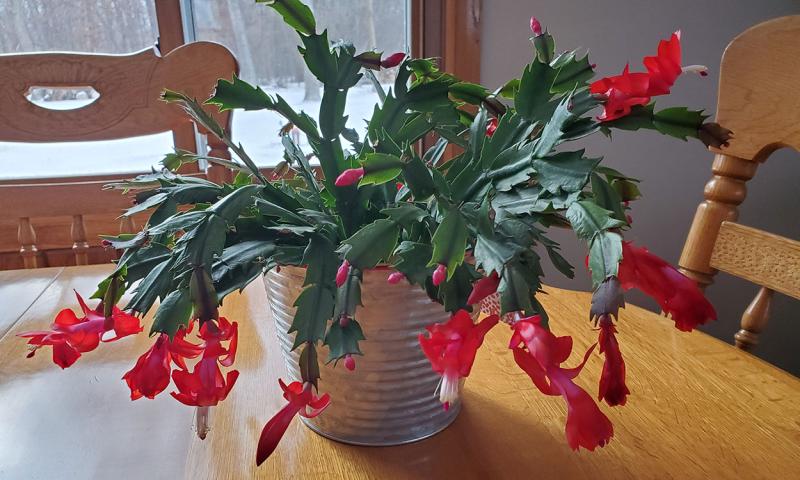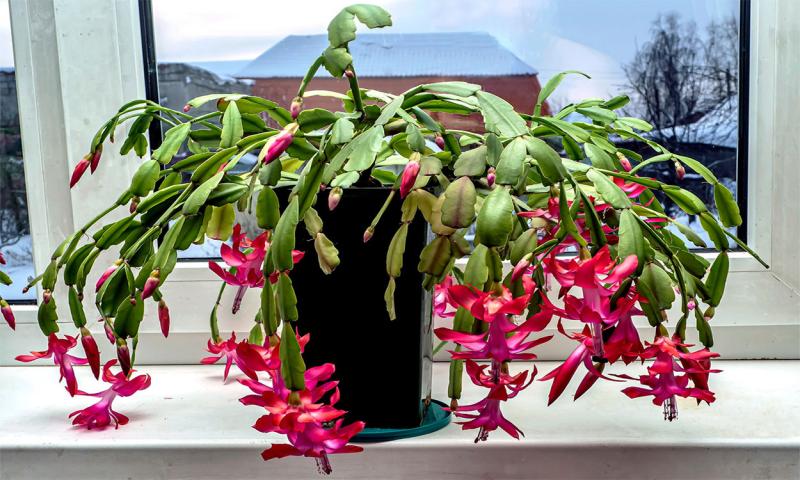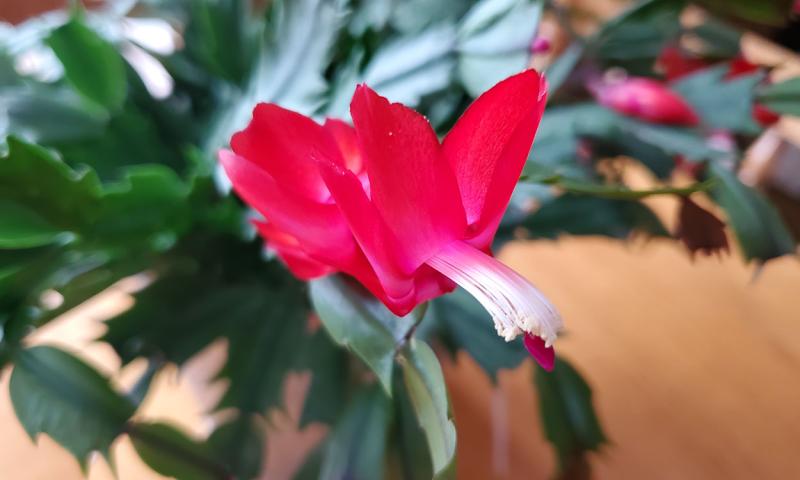
Written by Cindy Schnabel, South Dakota State University (SDSU) Extension Horticulture Assistant and Master Gardener, under the direction and review of Kristine Lang, SDSU Assistant Professor and Consumer Horticulture Extension Specialist.
The Christmas cactus is a very popular holiday houseplant. It is found in many retail locations during from November through December. Many people may not realize that there are three distinct species of holiday cacti, and often Christmas and Thanksgiving cacti are mistaken for one-another. This article explains the different types of holiday cacti and how to care for them. Plant lovers, from the novice to the expert, will be enjoy and care for these low-input, blooming plants.
Unlike other cacti, the holiday cactus does not thrive in the hot, dry environment that we associate with cactuses. Schlumbergera species are native to the rain forests of Brazil. They grow among the tree branches, where there is high humidity, dappled sunlight and warm temperatures.
Types of Holiday Cacti

There are three types of holiday cacti: the Easter cactus (S. gaertneri), the Thanksgiving cactus (S. truncata) and Christmas cactus (Schlumbergera x buckleyi). The blooming time for each of these cultivars corresponds to their names. Most of the cacti sold during the early portion of the holiday season are actually Thanksgiving cacti. Easter cacti are much less common in retail stores.
Thanksgiving and Christmas cactus are short-day plants that need long, dark nights for at least three weeks to induce flower bud formation. However, bud formation and flowering of the Easter cactus (Figure 1) is triggered when the winter nights begin to shorten, resulting in longer days. The response to daylength is part of the reason these three plants typically bloom in correspondence to the natural daylength in our northern hemisphere winters. Temperature also plays a role in this process.
If you purchased or inherited a holiday cactus, you may be curious which one you have. One way to distinguish between holiday cacti is the shape of the flattened stem segments. The Thanksgiving cactus segments have two to four saw-toothed serrations along the edge of the leaf (Figure 2); this has also been described as “sharply toothed.” The stem margins on the Christmas cactus are more scalloped or teardrop shaped (Figure 3). The Easter cactus has very rounded edges, which are centralized on the leaf (Figure 1). The flowers of Christmas and Thanksgiving cacti are tubular, with the ends of the petals folding backwards, giving a lovely bell appearance. The Easter cactus has a star-shaped flower that is very eye-catching.
Caring for Holiday Cacti

All three holiday cacti species need bright, indirect light. An east-facing window, or placement in a naturally lit, bright room is ideal. A daytime temperature of 65 to 70 degrees Fahrenheit and a nighttime temperature of 55 to 65 degrees Fahrenheit will ensure that holiday cacti thrive.
Holiday cacti are epiphytes in their natural environment, where they would collect water from the air and rainfall. For this reason, it’s best to keep holiday cacti in well-drained soils. You’ll want to avoid overwatering these plants, as they do not tolerate water-logged soils.
You can allow the soil to dry out between watering and use a finger test to determine when to water your cactus. When the top one-third of the soil feels dry to the touch, and the pot feels light when lifted, go ahead and water your cactus. When watering, soak the soil until water runs through the pot’s drainage holes. You can do this over the sink, or place a tray underneath the pot to catch the water. After 10 to 15 minutes of drainage into a pot tray, make sure to dump out the excess water so that the pot is not sitting in the drainage water. It’s important to note holiday cacti will use more water when flowering, and you can decrease watering after the plants have finished blooming.
During the spring through early fall, applying a balanced fertilizer (20-20-20) every two weeks will keep it healthy and growing. Reduce the amount of nitrogen (the first number in the analysis) that is given in the fall when buds are forming.
The holiday cactus will drop the blossoms if it is exposed to any kind of stress. The stress could come in from sudden changes in temperatures, changes in the amount of light or too much or too little water. The major disease it can get is root rot, which can be avoided by not over watering. Pest-related problems include mealybugs, soft brown scale, red spider mites and fungus gnats. Inspecting plants prior to purchasing is one way to avoid bringing an insect pest home.
Getting Your Holiday Cactus to Rebloom

The blooms of Thanksgiving and Christmas cactus are triggered by an interaction between cooler temperatures and longer nights. Three or more weeks with 12 to 14 hours of complete darkness will cause the plants to form buds. Nighttime temperatures near 55 degrees Fahrenheit will cause bloom formation to happen more quickly. When nighttime temperatures are warmer than 55 degrees, which is likely the case in most homes, complete darkness for 12 to 14 hours is even more critical. If your plant is left in a room where lights are on late into the night, this could delay or bud-set. You may consider covering up the cactus to maintain the continuous darkness. Flower bud formation of Thanksgiving and Christmas cacti are optimized when the plants are kept in rooms with temperatures less than 65 degrees Fahrenheit. Unlike its winter-blooming counterparts, the Easter cactus will initiate blooms under warmer temperatures as days lengthen.
With proper establishment and care, holiday cacti can live at least 20 to 30 years. There have even been some that have aged to at least 100 years old. The holiday cacti are relatively easy to grow, and their gorgeous flowers and long blooming time make them a must for the holiday season.
References and Additional Resources
- Weisenhorn, Julie. 2020. Easter cactus brings spring color indoors. University of Minnesota Extension, Minneapolis-St. Paul, Minnesota.
- Weisenhorn, Julie. 2018. Holiday cacti. University of Minnesota Extension, Minneapolis-St. Paul, Minnesota.
- Nau, J., B. Calkins, and A. Westbrook. 2021. Ball Redbook Volume 2: Crop Culture and Production (19thed). Ball Publishing, West Chicago, Illinois.


